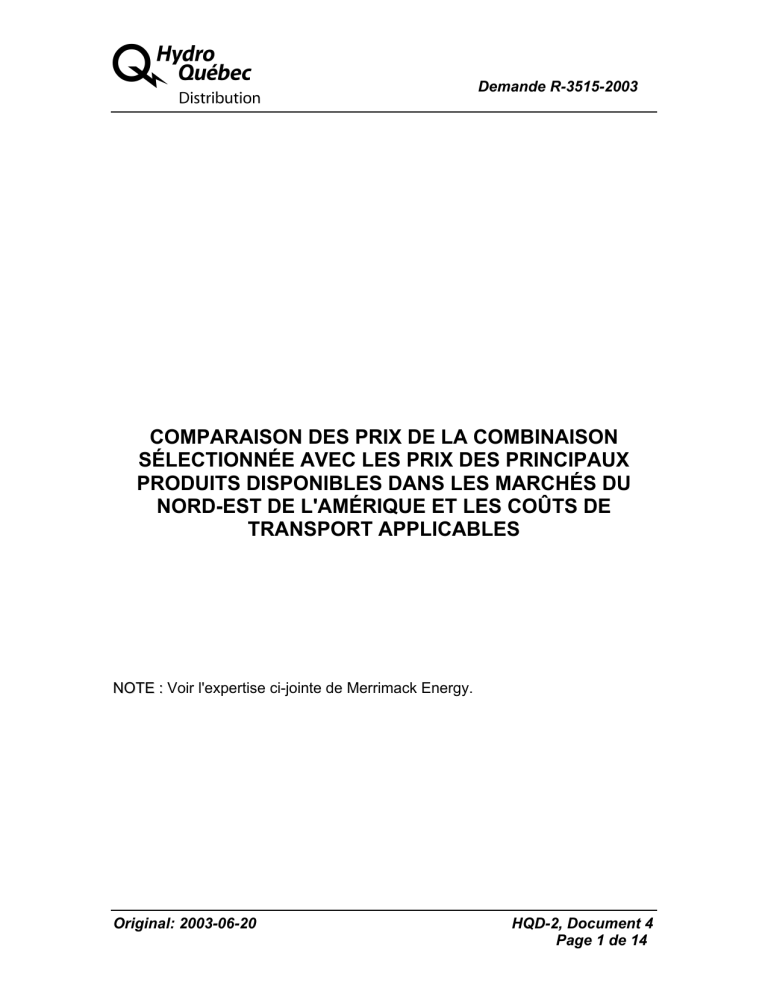A

A
Demande R-3515-2003
COMPARAISON DES PRIX DE LA COMBINAISON
SÉLECTIONNÉE AVEC LES PRIX DES PRINCIPAUX
PRODUITS DISPONIBLES DANS LES MARCHÉS DU
NORD-EST DE L'AMÉRIQUE ET LES COÛTS DE
TRANSPORT APPLICABLES
N O T E : : Voir l'expertise ci-jointe de Merrimack Energy.
Original: 2003-06-20 HQD-2, Document 4
Page 1 de 14
A
Demande R-3515-2003
The Competitive Cost of Power in the Northeast Market
1. Introduction
The Regie de l’energie (Regie) requires that Hydro-Quebec Distribution undertake a comparative analysis of the cost of power from the bids selected through the 2002 Call for Tenders process relative to the price of power from the
Northeast market (defined as New England and New York markets). Such a direct and equivalent comparison is difficult since the bids requested by Hydro-
Quebec Distribution and the contracts signed were long-term 20-year firm arrangements, while comparable long-term firm arrangements in the restructured wholesale market in New England and New York are non-existent. In fact, we are not aware of any 20-year contracts that have been signed in the Northeast over the last five plus years. This raises a fundamental question regarding the appropriate type of power arrangement and the competitive pricing mechanism to use for establishing the basis of comparison between the Northeast market price and contracts negotiated by Hydro-Quebec Distribution.
While spot price data is readily available, spot transactions do not contain the same level of reliability as long-term firm transactions, such as the contracts signed by Hydro-Quebec Distribution. Furthermore, spot prices have been very volatile since the restructuring of the Northeast markets to a bid-based market structure. Most power market price forecasts or forward curves reflect the price of spot power and do not address the value of reliability of long-term supplies or unit contracts.
To address this issue, it is necessary to assess recent market activity and contractual practices and suggest an appropriate mechanism for comparison.
This assessment will describe recent market trends regarding contracting practices, describe a methodology for undertaking the analysis and present the results. The results of the analysis are based on a comparison of the projected cost of the selected combination of resources by Hydro-Quebec Distribution (i.e.
250 MW cycling from Hydro-Quebec Production, 507 MW baseload from
TransCanada Energy Ltd. (TCE), and 350 MW baseload from Hydro-Quebec
Production) with the estimated cost of alternative options from the Northeast market.
Currently, most wholesale transactions in the Northeast market are short-term spot, day-ahead, or month-to-month contracts. Some of the small municipallyowned utilities in New England have entered into contracts with 2 to 4 year terms, but such contracts have not been widespread. There is recent evidence that the trend may be changing on a limited basis. For example, the Long Island
Original: 2003-06-20 HQD-2, Document 4
Page 3 de 14
A
Demande R-3515-2003
Power Authority (LIPA) has entered into a long-term electric transmission rights contract and it is our understanding that LIPA is in the process of negotiating a long-term Power Purchase Agreement (up to 20 years) for the purchase of power from a new combined-cycle unit located on Long Island. Also, distribution utilities secure Standard Offer Service and Default Service for customers who elect to retain utility service, rather than purchase generation service from a marketer.
Both services are acquired through a competitive bidding process in several states at term lengths ranging from six months to approximately one year.
At the generation level, New England currently has a short-term generation surplus, which could last from 2005 to 2011 depending on the level of retirements of existing units. Nevertheless, based on recent market activity and legislative, environmental and regulatory policies, it is expected that the marginal source of generation capacity in both New England and New York will continue to be gasfired combined cycle facilities. Thus, it can be expected that the price of power under a long-term contract should reflect the all-in cost of building a new gasfired combined cycle facility. The rationale for this conclusion is discussed in more detail in this analysis.
The methodology undertaken by Merrimack Energy to assess the competitive cost of long-term power in the Northeast compared to the contract prices selected by Hydro-Quebec Distribution in the Call for Tenders process is based on utilizing known information about gas-fired combined cycle power generation costs in the Northeast and develop a cost of power from a merchant power plant in the Northeast as a basis for comparing the costs to the bids selected.
For this assessment the cost of providing long-term power from the Northeast to
Quebec will consist of the following components:
(1) A capacity charge which reflects debt service costs, a return on and of capital and selected taxes;
(2) A fixed O&M cost which reflects fixed labor costs, a maintenance reserve fund, property taxes, and insurance;
(3) A variable O&M cost which reflects variable operating costs such as labor, materials, and consumables;
(4) Fuel costs to deliver the gas to the plant based on a reasonable fuel procurement strategy as implemented by others in the Northeast; and
(5) Transmission costs for wheeling the power from the Northeast to the
Quebec border.
Original: 2003-06-20 HQD-2, Document 4
Page 4 de 14
A
Demande R-3515-2003
This assessment is presented in five sections, in addition to the Introduction.
Section 2 provides a brief description of the Northeast power market with a focus on the types of products contracted in this market. This section will describe the trends in the power procurement process and demonstrate the reason why longterm 20-year contracts have not been prevalent in this market. Section 3 will describe the theoretical basis for the methodology undertaken. Section 4 will describe the assumptions used for calculating the long-term cost of power based on the economics of recovering the costs of building a new combined-cycle unit, including a return on equity necessary to undertake the risk of building a merchant plant. Section 5 provides the comparative analysis of pricing in the contracts secured from the Call for Tenders relative to the cost of long-term power from a facility in the Northeast.
2. Power Procurement Trends in the Northeast Power Market
Power procurement initiatives have changed dramatically over the past twentyfive years in the Northeast power market. The wholesale electric power markets in both New England and New York were traditionally organized under power pool structures. Utilities in these regions, as in other parts of the US and Canada, were historically vertically integrated and maintained a requirement to build or buy power supplies to meet firm customer loads under the regulatory compact that required utilities to serve all customers, in return for the opportunity to earn a reasonable return on their investment.
The wholesale market in the Northeast began to change with the implementation of the Public Utilities Regulatory Policy Act (PURPA) in 1978. Under PURPA, utilities were essentially required to buy power from qualifying facilities at the utility’s projected long-run avoided costs. Qualifying facilities included cogeneration projects using fossil fuel, such as coal or natural gas, as long as the facility met the energy efficiency requirements under PURPA. States in the
Northeast were among the most aggressive in implementing PURPA. By the mid-
1980’s, many utilities in the Northeast had signed contracts for power in excess of their needs and at prices that proved to be significantly above the utility’s actual avoided costs.
One of the responses of utilities in the Northeast to this issue was the institution of competitive bidding for power supplies. By the late 1980’s, most investorowned utilities in the Northeast that projected a need for new power supplies instituted competitive bidding programs, as a means of soliciting bids for longterm power supplies. At this time, utilities were still contracting for long-term supplies to meet firm customer needs.
Original: 2003-06-20 HQD-2, Document 4
Page 5 de 14
A
Demande R-3515-2003
The Energy Policy Act of 1992 in the US ushered in the initial movement toward wholesale electric market restructuring by attempting to open up the electric transmission grid to wholesale transactions. Wholesale and retail market restructuring initiatives began to gain momentum shortly thereafter. Utilities recognized that stranded cost had to be addressed if market restructuring was to be effectively implemented. By the mid-1990’s based on the regulatory uncertainty associated with the move toward market restructuring and concern over treatment of stranded cost, utility planners began to focus on shorter term contracts and option arrangements, rather than sign long-term contracts that may exacerbate the stranded cost situation if markets were restructured and customers had the opportunity to contract for third-party power supplies.
The change in the wholesale market to a bid-based power pool and Independent
System Operator (ISO) in the later part of the 1990’s led to creation of a spot market in power, with hourly prices generally established based on the price bid by the unit which meets the last increment of demand.
Restructuring in the Northeast has resulted in most electric utilities selling their generation assets to third-parties. Along with the divestiture of generation assets, a number of new merchant power plants (merchants are defined as facilities developed and built without the sale of long-term contracts for the output of the facility) have been developed or are under construction.
The combination of the divestiture of utility generation and the development of new merchant generators means that few term contracts exist and most power projects have to compete to meet load through the wholesale market. Most facilities sell their power into the ISO on a spot basis or under short-term (dayahead or month to month) contracts. Very few (if any) long-term contracts have been signed in the Northeast over the past five years and certainly no 20-year contracts have been signed to our knowledge. While LIPA is pursuing a long-term contract, it is important to note that LIPA’s Long Island market area is somewhat unique because it is an island with limited electric transmission access and with a stated requirement for generation to be built on the island to meet load. The NYISO requires that nearly all the generation to meet load in Long
Island has to be located on Long Island.
In most states that have restructured their electric markets, timelines have been established for retail customers to procure power from marketers beginning as soon as this year. Since electric utilities have sold their generation assets, they are not required to maintain the power supplies to meet customer needs.
Currently, utilities are now the suppliers of last resort, either contracting for standard offer service through an RFP for power for up to a one-year term or securing default service via a short-term solicitation.
Original: 2003-06-20 HQD-2, Document 4
Page 6 de 14
A
Demande R-3515-2003
In any case, there is virtually no evidence of long-term contracts being signed in the Northeast. The restructuring of the electric market has led to a trend toward short-term contracts or spot transactions. Since utilities have sold their assets and are expected to be out of the power supply business, utilities will not issue
RFPs for long-term power. Only municipal utilities may be interested in term contracts, since they maintain the requirement to supply their customers.
However, even the municipal utilities have resorted largely to short or mid-term
(2-4 years) transactions.
Thus, there are no currently comparable arrangements in the Northeast market that can serve as a representative indicator by which to compare the cost of the power under the contracts negotiated by Hydro-Quebec Distribution. Certainly, the spot market price is not a reasonable indicator for establishing a long-term price. As previously noted, reliance on the short-term or spot market does not offer the same reliability or price stability as a long-term contract would. Also, the experience in the Northeast market has illustrated that spot energy prices have been very volatile since the markets opened in 1999. High price volatility adds risk and uncertainty to pricing.
3. Methodology
In the absence of long-term contracts as a guide for establishing long-term market prices for firm arrangements, a market price proxy needs to be established. To estimate the cost of power under a long-term contract providing the same level of reliability as the power contracted by Hydro-Quebec
Distribution under the Call for Tenders, it is logical to estimate the cost of building and operating a new combined-cycle plant, as the basis for the long-term cost under the contract. This is based on the theory that long-term market prices should converge to the price of a new gas-fired combined cycle project, which is the incremental source of capacity in the Northeast.
Developers of such facilities will only construct these facilities if the market price of power is sufficient to cover all development and operating cost, including a reasonable rate of return. If market prices are above this level, new merchant power projects will be built to meet market demand. Also, power suppliers (even with existing generation facilities) will not be willing to make long-term commitments below this cost, since they would either have to go to the market to meet their obligations at higher market prices or would forego the opportunity for higher revenues by selling below the long-term market price. In the absence of representative long-term contracts, suppliers will also evaluate the cost of power from the incremental generating source when pricing long-term power supplies.
Original: 2003-06-20 HQD-2, Document 4
Page 7 de 14
A
Demande R-3515-2003
For this analysis, the cost of building and operating a new combined-cycle plant in the Northeast will be used as a representative competitive option. The capital and operating costs of existing and proposed units in the Northeast will be utilized as the basis for establishing such costs. The fuel costs are assumed to be treated as a “passthrough” and will be based on the pipeline options and fuel procurement strategies followed by merchant power plants in the Northeast.
Finally, the transmission rates associated with moving power from the applicable regions in the Northeast to the Quebec border will be included based on the costs which would be incurred to deliver power to the Quebec border.
4. Analysis Assumptions
As noted, the assumptions used in the analysis are based on the construction and operations of a merchant power plant. Currently, most merchant power plants have little or no portion of their power contracted for the mid to long term.
For the most part, these units bid power into the wholesale market and rely on the revenue from spot energy sales or short-term transactions as their major source of revenue to pay debt service and to provide a return on equity. Unlike long-term power purchase contracts (such as the contracts negotiated by Hydro-
Quebec Distribution with TransCanada Energy Ltd. and Hydro-Quebec
Production), merchant power plants are highly dependent on the market for their revenues.
The current high level of price volatility creates a real challenge for these units to achieve adequate revenues to cover costs and provide a reasonable return on equity. In fact, our analysis demonstrates that over the past two years, merchant generators in New England have achieved very low returns on equity due to the depressed spark spreads (i.e. the difference between the power price and the cost of fuel, adjusted for the unit heat rate). This has raised concern in the financial community about the very real potential of financial default and ultimate bankruptcy for several units. As a result, the analysis includes an implied return on equity that reflects the market risk associated with merchant generation.
To ensure consistency in the evaluation process, this analysis relies upon the same input assumptions used by Hydro-Quebec Distribution in its Stage 2 and
Stage 3 analysis of the bids received in response to the 2002 Call for Tenders.
This includes fuel price forecasts and basis, inflation rates for Canada and the
US, the exchange rate, discount rate, etc.
The first component in the analysis is the capital cost and associated capacity price which needs to be recovered as a fixed cost to pay for debt service, return on equity, taxes, depreciation and insurance. In this analysis, a levelized cost is established to reflect a fixed annual contribution to capital necessary to
Original: 2003-06-20 HQD-2, Document 4
Page 8 de 14
A
Demande R-3515-2003 adequately compensate the developer. The major financial assumptions used in this component of the analysis are listed in Table 1 below:
Table 1
Financial Assumptions
For a Merchant Power Project
Project Capital Cost $650/kW
Project 500
Ratio
MW
65%/35%
Implied Return on Equity
Debt
20% years
The estimated capital cost is based on the capital cost reported by 6 projects in
New England. This information, derived from financing documents, is illustrated in Exhibit A. While the average capital cost for the New England projects equals
$675/kW, we have conservatively assumed $650/kW. This reflects the fact that economies of scale exist in power generation development and the 500 MW plant size assumed exceeds the majority of the plants reported. The other assumptions reflect typical financial parameters in the merchant generation market. It should be noted that given the current financial state of the market it is likely that debt costs will be higher and more equity will likely be required to support financing. This would result in a higher required capacity charge.
The result of this assessment is a levelized capacity charge of $125.78 per kWyear in US dollars. This value is converted to Canadian dollars using the estimated exchange rates assumed by Hydro-Quebec Distribution in its Stage 2 analysis.
The second major cost component is the Operations and Maintenance (O&M)
Costs. The O&M costs are based on an analysis of eight gas-fired combined cycle plant proposals from various regions of the US from the 1999-2000 time frame. Seven of the eight projects had estimated O&M costs that were fairly consistent and one had an O&M cost dramatically above all others. This outlier was eliminated and the average O&M cost for the other seven projects were used in the estimate for the O&M costs. Based on this analysis, it is assumed that Fixed O&M costs would equal $1.13 per kW-month (US$) and variable O&M costs would equal $1.48/MWh in 2001 and would escalate by the rate of inflation
Original: 2003-06-20 HQD-2, Document 4
Page 9 de 14
A
Demande R-3515-2003 thereafter. O&M costs are also adjusted by the exchange rate to convert the cost stream into Canadian dollars for comparison purposes.
The third cost component is electric transmission costs. The seller of the power in the Northeast will have to contract for firm electric transmission service to deliver the power to the Quebec border. If the power is emanating in New
England, the supplier would have to contract for Through or Out Service with the
ISO as well as contract with an owner of the New England/Hydro-Quebec
Interconnection facilities (HVDC line connecting the New England Power Pool and the Hydro-Quebec system) to deliver the power to the Quebec border.
Through or Out Service has a current rate of $15.14/kW-year. The US portion of the HVDC system is financed through annual support payments by current owners.The annual support payments for such facilities equates to approximately
$70/kW-year, although the owners could charge less for such service because any sale would contribute to reducing the fixed cost obligations. Also, it is possible the US portion of the HVDC system may be rolled-in to the New
England transmission system at a future date.
For this analysis, it is assumed that the supplier will contract for Through or Out service at the full firm rate as well as service on the US portion of the HVDC facilities at $2.50 per MWh to move the power to the Quebec border. The analysis further assumes that the cost of this service will increase annually by the rate of inflation. This assumption may be conservative, since ISO New England has reported that it plans major expenditures for transmission system improvements and upgrades (estimated at $900 million). Both a roll-in of the HQ
Interconnection facilities and the transmission system improvements would likely lead to increases in the transmission costs in New England.
In New York the transmission service and rates are slightly different. To transmit power from a utility service area in New York to the Quebec border would require the supplier to pay a revenue-requirements based Transmission Service Charge
(TSC), as well as other charges (i.e. NYPA Transmission Adjustment Charge, ancillary service and operating reserve charge). The TSC is the fee paid by all wholesale transmission customers to the appropriate Transmission Owner. For exports, the rate is based on the transmission rate for the utility from whose territory the power leaves New York. In this case, the utility transmission owner would be the New York Power Authority (NYPA). The latest reported rate for service from the New York Power Authority to Chateauguay is $2.19 per MWh plus $1.67 per MWh for other charges for a total of $3.86 per MWh .
The final major cost component is fuel costs. There are several options available for merchant generators to source their natural gas supplies. However, it should be noted that most power projects either contract for limited amounts of firm pipeline capacity and purchase their gas at a liquid hub or rely on a marketer for
Original: 2003-06-20 HQD-2, Document 4
Page 10 de 14
A
Demande R-3515-2003 delivered service. This analysis evaluates several fuel procurement options since the location of the plant will dictate the preferred source of gas.
Three plants were used as theoretical examples of competitive alternatives to supply power to Quebec. All three plants are gas-fired combined cycle plants with one located in New York and two located in the New England region. The gas supply/transportation options are considered: a) Source gas at Dawn and deliver the gas to central New England via
Union-TransCanada Pipeline through Niagara on Tennessee Gas
Pipeline (Zone 5-6). b) Source gas in New York and deliver gas to Southern New England via
Algonquin Gas Transmission System. c) Source gas at Dawn and transport gas to upstate New York via
TransCanada Pipelines (TCPL) and Iroquois Gas Transmission
System.
The first New England plant is assumed to source gas at Dawn and uses the
TCPL transportation path to Niagara and then uses the Tennessee system Zone
5 & Zone 6 to transport to New England. Also, it has been assumed that a lateral will be required to attach the plant to the Tennessee system. This is a common route and tariff rates were used to estimate the transportation costs. We have assumed that the power would be generated by one of the newly constructed plants in the region. The existing transportation rate on TCPL to Niagara and
Tennessee for Zone 5 to Zone 6 is currently $0.32 US/MMBtu. If we are assuming a new plant would need to be constructed, then incremental transportation capacity would have to be constructed on the Tennessee system and that would bump the toll up to $0.90 US/MMBtu. (assuming that it could not be rolled-in).
The second New England plant is assumed to source gas at Transco Z6 and uses the Algonquin transportation path into New England. Again we have assumed that a lateral will be required to attach the plant to the Algonquin system. This is also a common route for power plants sourcing gas in southern
New England, including the states of Connecticut, Massachusetts, and Rhode
Island. The existing transportation rate on Algonquin is $0.235 US/MMBtu.
Incremental tolls for new construction on Algonquin would not likely be eligible for rolled in rate treatment and therefore would also be in the 80-90¢ US/MMBtu.
The third plant was assumed to be located in New York State off of the Iroquois system. The gas is again sourced at Dawn and the transportation path includes
Original: 2003-06-20 HQD-2, Document 4
Page 11 de 14
A
Demande R-3515-2003 using TCPL to transport gas from Dawn to Waddington, New York. From
Waddington, the gas would be shipped on the Iroquois system to the southern zone. The existing transportation rate on Iroquois is $0.437 US/MMBtu. If a new plant was constructed near the Iroquois system, it is likely that there is sufficient expansion capacity on the system and construction of new capacity would only involve compression. Usually when compression is added, rather than looping of the pipeline system, the rates stay close to the current rates and usually the incremental costs are eligible for rolled-in rate treatment.
In conclusion, a new gas-fired combined cycle plant located in New England would obtain gas off of the Tennessee system or the Algonquin system. The
Algonquin system tends to source its gas from the Gulf Coast, but a merchant plant would purchase gas at a liquid point on the system, e.g. Algonquin M3 or
Transco Z6. The Tennessee system is fed from Canada (Dawn and Sable gas at
Dracut) as well as with gas from the Gulf Coast. The Dracut point is not liquid enough, so it is likely that a buyer would use Dawn gas as a pricing point or at a storage site in the Northeast. If the merchant plant does not have capacity on these pipelines, then it would likely use a marketer to supply a city-gate service – this is where the marketer goes into the market and buys both the commodity and the transportation capacity on behalf of the merchant plant. To be consistent with the Hydro-Quebec Distribution Call for Tenders, all of the commodity prices were the same as the forecasts used in the Stage 2 and Stage 3 analysis.
5. Results of the Analysis
The results of the analysis are illustrated in Table 2 below. The results are presented on a real levelized cost basis, using the same methodology used by
Hydro-Quebec Distribution and Merrimack Energy in Stage 2 and Stage 3 analysis.
Original: 2003-06-20 HQD-2, Document 4
Page 12 de 14
A
Demande R-3515-2003
Table 2
Analysis Results
Real
Combination of Contracts
New England (Dawn Gas Supply)
New England (New York Gas Supply)
6.7 cents
7.2 cents
New York (Dawn Gas Supply) 7.0 cents
The results of the analysis clearly indicate that the selected combination or portfolio of resources (i.e. 250 MW of cycling from Hydro-Quebec Production,
507 MW from TCE, and 350 MW of baseload from Hydro-Quebec Production) provides long-term power supplies to Hydro-Quebec Distribution at a price lower than a comparable contract from the Northeast power market. This difference is driven primarily by higher capacity charges for the Northeast facilities to reflect the higher risk associated with merchant power market uncertainty and price volatility and the additional cost associated with the transmission of power to the
Quebec border.
The fuel costs associated with the options for sourcing gas at Dawn for delivery of gas to New England or New York are comparable to delivery of gas to a similar project located in Quebec. The price forecast for gas from New York
(Transco Zone 6) is high relative to Dawn, resulting in significantly higher prices via domestic US supplies.
An offsetting factor is the better estimated heat rate associated with a pure merchant facility as opposed with the guaranteed heat rate of the Becancour project.
We have assumed the capital and O&M costs to be the same for merchant plants built in New York and New England since we would assume a plant which is used for export would not be built in New York City where construction costs are much higher.
In conclusion, the results illustrate that the power costs for the contracted power from Hydro-Quebec Distribution’s Call for Tenders ranges from 10% to 18% lower than comparable power from the Northeast US.
Original: 2003-06-20 HQD-2, Document 4
Page 13 de 14
A
Demande R-3515-2003
Exhibit A
All-in Capital Costs of Merchant Power Projects in the Northeast
Project Name:
New England
Dighton Power
Berkshire Power
Tiverton Power
Lake Road
Millenium
Androscoggin Energy
Weighted Average
New York
Athens
Spagnoli Road
Project Developer
EMI/Calpine
El Paso
EMI/Calpine
PG&E
PG&E
Polsky Energy
PG&E
KeySpan
(MW)
792
360
157
168
274
240
1080
250
(Million $)
$136,50
$200,00
$172,00
$490,00
$240,60
$105,00
$665,30
$275,00
Cost/kW
$812,50
$729,93
$716,67
$618,69
$668,33
$668,79
$675,09
$616,02
$1 100,00
Original: 2003-06-20 HQD-2, Document 4
Page 14 de 14







